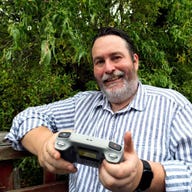'ZDNET Recommends': What exactly does it mean?
ZDNET's recommendations are based on many hours of testing, research, and comparison shopping. We gather data from the best available sources, including vendor and retailer listings as well as other relevant and independent reviews sites. And we pore over customer reviews to find out what matters to real people who already own and use the products and services we’re assessing.
When you click through from our site to a retailer and buy a product or service, we may earn affiliate commissions. This helps support our work, but does not affect what we cover or how, and it does not affect the price you pay. Neither ZDNET nor the author are compensated for these independent reviews. Indeed, we follow strict guidelines that ensure our editorial content is never influenced by advertisers.
ZDNET's editorial team writes on behalf of you, our reader. Our goal is to deliver the most accurate information and the most knowledgeable advice possible in order to help you make smarter buying decisions on tech gear and a wide array of products and services. Our editors thoroughly review and fact-check every article to ensure that our content meets the highest standards. If we have made an error or published misleading information, we will correct or clarify the article. If you see inaccuracies in our content, please report the mistake via this form.
How I used a $170 thermal camera to check my GCFI breaker - and why this one's worth it

Regular readers will know that I am a little obsessed with thermal imaging cameras. I regularly use them built into smartphones, those that can be attached to smartphones, and standalone cameras. I use them for everything from spotting failing components on circuit boards, finding leaking pipes, finding spots in houses where heat is leaking, and problems with car brakes or cooling systems.
I'm always finding new uses for my thermal cameras. Personally, I prefer standalone ones because they are perfect for throwing into a toolbag and are always there when you need them.
Also: The best electric screwdrivers
The problem is, a lot of the standalone cameras are expensive, especially if you want one with decent accuracy and thermal range. But sometimes you come across one with said accuracy but without the hefty price tag -- one such example is the HF96V from HSFTools.
The HF96V features a 96 x 96 IR camera along with a 640 x 480 visible camera to offer three imaging modes: thermal only, visual only, and fusion. If that 96 x 96 thermal camera sounds rather meager, don't worry, because the image is upscaled to 240 x 240 in real-time, and it updates at a speed of 25Hz (that's 25 times a second).
Also: 5 gadgets I can't go off-grid without (and why they make such a big difference)
The thermal image camera has a 50-degree field of view, wide enough to provide broad coverage during scanning but narrow enough to isolate specific components. It also has a wide temperature range from -4°F to 1022°F (-20°C to 550°C) in increments as small as 0.09°F (0.05°C), with a temperature reading discrepancy within ±2%.
Measuring the temperature of filament being extruded by my 3D printer.
High-quality images are vital for accurately diagnosing faulty components. I've tried using cheap cameras with poor-quality output, and they're just not up to the job.
The thermal camera also has the ability to accommodate different distances to objects and fine-tune emissivity settings based on specific materials (such as PCBs, ceramics, and rubber) to allow for more accurate temperature measurements on a variety of substances.
Keeping an eye on the temperature of a GCFI breaker.
The thermal camera has a trigger that activates a laser with a press and takes a photo with release. This results in two photos being taken, thermal and visual, which can be accessed from the camera or downloaded to a computer using a USB-C cable. Photos are stored on 4GB internal storage, which is enough for 30,000 images.
Also: I finally found a pocketable multitool for less than $30 that isn't junk
The unit has a 3,350mAh rechargeable battery using the USB-C port, and it gave me about 7.5 hours of runtime per charge. It also held its charge very well when the camera was stored.
Thermal cameras also work in the dark.
The tool is built tough and can survive drops onto concrete from 6 feet. It is IP54 rated for dust and water resistance (limited protection from dust ingress and protection from water splashes from any direction). There is also a 1/4-20 threaded hole in the base of the handle for attaching the camera to a tripod.
ZDNET's buying advice
The HSFTools HF96V is a superb mid-level thermal camera offering a lot more than the basic models for not much more money. The thermal output quality is more than enough for all but the most demanding professional needs, and in a package that's built to survive a tough life and a battery that will last the average user weeks, if not months.
Usually retailing for $220, there's currently a $50 off coupon on Amazon, bringing this thermal camera down to a very reasonable $170.
Looking for the next best product? Get expert reviews and editor favorites with ZDNET Recommends.
